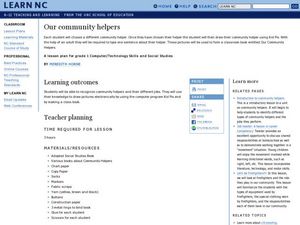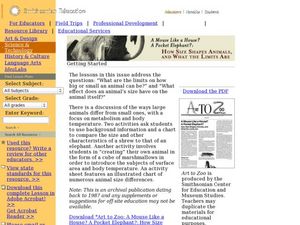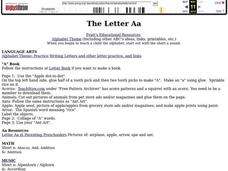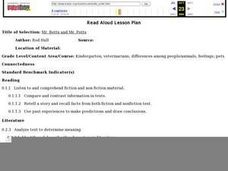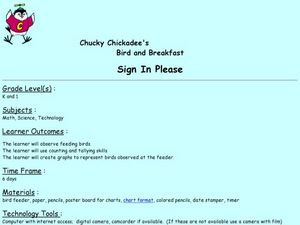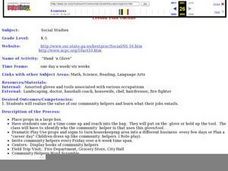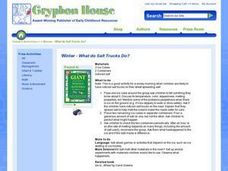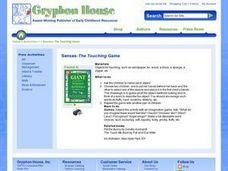Curated OER
Count on Science & Math for Your Future
Young scholars complete a variety of classroom and online activities designed to teach them the importance of science and math in all career paths and stimulate their awareness and interest in various careers.
Curated OER
Shapes and Tools
Young learners view different shapes drawn by the teacher on the board. The teacher identifies each shape by name and discusses the importance of knowing the difference between shapes when building something. The pupils complete the...
Curated OER
"Our Community Helpers"
Students define the term community. They list many, varied, and unusual jobs (careers) that people might have in our Communities. Students identify the purpose of the work done by their parents-either in the home, or outside of the home....
Curated OER
Math: Divide and Conquer - Equivalent Fractions
Students engage in hands-on activities and observe videos to develop fraction skills. In one activity, they create "paper pizzas" complete with original toppings. By swapping pieces, students display whole and unique-looking pizzas.
Curated OER
How Size Shapes Animals
Learners investigate how size affects large and small animals differently. In this animal lesson plan, students determine how size affects different animals by constructing their own animal out of marshmallows. Once learners create...
Curated OER
The Letter Aa
Students explore letter Aa. In this letter recognition instructional activity, students participate in country, state, food, literature, physical education, colors, careers, music, and game activities that are linked to the main...
Curated OER
The Letter Ww
Students explore letter Ww. In this letter recognition lesson, students participate in country, state, food, literature, physical education, colors, careers, music, and game activities that are linked to the main lesson page. Students...
Curated OER
"Mr. Betts and Mr. Potts"
First graders listen to the book "Mr. Betts and Mr. Potts" and examine the career of being a veterinarian. They categorize animals based on whether they could be house pets or not, develop a class pet graph, and list the various...
Curated OER
Chucky Chickadee's Bird and Breakfast: Sing in Please
Students observe bird feeding and complete a tally and graphing activity for their observations. In this bird graphing lesson, students work in teams to observe bird feedings. Students complete a bird reporting sheet and collect data...
Curated OER
Dinosaurs Were Real!
Students investigate the history of dinosaurs, as real animals. In this dinosaur lesson plan, students examine basic concepts that help them understand the history of all life. Included in this article is information on the world of the...
Curated OER
Look Ma! I'm a Rocket Scientist!
Students use a ball to push and pull to demonstrate the concept of force. In this force lesson plan, students talk about the importance of force in space and use balls to demonstrate this phenomena.
Curated OER
Summertime -- Camping Memory Game
Students discuss the items needed to camp outside. They identify objects in a backpack and tell what the item could be used for. They hide the objects throughout the room and they are to find them.
Curated OER
Recycling
Young scholars investigate how to reduce, recycle, and reuse items in order to conserve natural resources. They complete a trash graphing activity after discussing different types of trash. Finally, the examine ways to buy recycled...
Curated OER
Make Your Own Thermometer
Students recognize the concept of temperature, including degrees, and the melting and freezing process. In this 1st - 2nd grade lesson plan, students identify the temperature of various objects, as well as create their own paper...
Curated OER
"Hand 'n Glove"
Students identify community helpers and learn about their jobs with this role-play game.
Curated OER
Weather -- Snowmen in May
Young scholars are read the story "Snowballs" and discuss what the conditions must be for it to snow. They make snowmen out of snow when it snows outside. They discover what happens to their snowmen when they take them inside.
Curated OER
What Do Salt Trucks Do?
Students predict what will happen to ice when salt is put on it. They make observations and discuss what actually happened to the ice. They relate their experiment to the salt trucks they see on the street.
Curated OER
Senses -- The Touching Game
Students practice making educated guesses about objects in their hands. They guess what the object is without looking at it and choose a word that describes it. They practice using new vocabulary as well.
Curated OER
Officer Buckle and Gloria
Students write a class letter to a local policeman asking him to come and talk to the class and create a list of safety tips as a class. Students research information on police dogs: type of dogs used, where they come form, how they are...
Curated OER
The Westward Movement
Students study the westward movement through examining stamps. For this westward movement lesson plan, students draw conclusions, determine cause and effect relationships and examine the westward movement of the United States by...
Curated OER
Learning from Letters and Other Mail
Students explore the history of our mail system. In this postal lesson plan, students evaluate mail as a means of communication, create a mail system in their classroom where they can send and receive mail. Once the students receive...
Curated OER
Maskmaking
Students examine masks from various cultures focusing on the Native Americans. Using the internet, they research the purpose of the masks and various designs. They create their own mask showing their own culture and personality and...
Curated OER
Art to Zoo: Celebration
Students research and develop a report on birthday rituals around the world. In this research lesson plan, students compare birthday rituals from other cultures to their own. Images and resources are included.
Curated OER
Teaching With the Power of Objects
Students define value of an object. In this value lesson plan, students identify reasons for collecting objects, compile a personal inventory of items they find valuable, and then define why those items are valuable to them. In step two...


